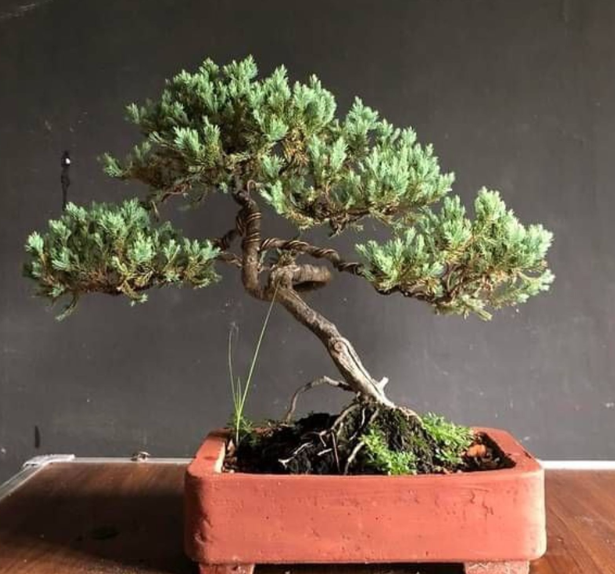The word bonsai has been derived from the Japanese word ‘Bon’ meaning shallow pan and ‘Sai’ meaning plant, refers to the unique art of growing miniature trees. This specialized cultivation method involves planting trees in small pots or urns, restricting nutrient intake, limiting root growth space, and carefully pruning shoots.

These techniques create the appearance of a full-sized tree in miniature form, showcasing the essence of nature on a smaller scale. Thus, ‘It is the art of growing and training plants to be miniature of their natural forms’. It has great importance in the modern landscaping of houses, restaurants, hotels, parks, etc.
The art of bonsai is a blend of horticulture and aesthetics. Depending upon the height of the bonsai plant it can be categorized as large bonsai which are over 60 cm, medium bonsai ranging from 30 to 60 cm, small bonsai are between 20 to 30 cm, and mame bonsai are less than 20 cm. Mame bonsai, in particular, are extremely small plants that do not exceed 20 cm in height, often referred to as miniature.
Originating in China and refined in Japan, bonsai has evolved over centuries into a sophisticated practice that requires patience, precision, and a deep understanding of plant biology.
Practices in Bonsai Cultivation

A well-proportioned bonsai design features an intriguing root structure, a trunk that tapers gracefully, a harmoniously arranged set of branches, and a container that complements the size of the tree. Creating a bonsai is both a technical and artistic endeavor. It involves several key practices:
Selection of Species:
All the plants are not suitable for bonsai. Due to the long tradition of cultivating this art in Japan, the suitability of various plants for different bonsai styles has been thoroughly tested and confirmed. One of the most critical factors determining a plant’s suitability for bonsai is its hardiness. A bonsai specimen can be a tree, shrub, or climber, but it should meet the following criteria:
- Must be hardy.
- Must respond well to pruning and training (both roots and branches) while maintaining the appearance of a natural plant.
- Must thrive in a shallow container.
- Must harmonize well with the container or pot.
- Must have a strong and thick trunk at ground level for a natural look.
- Should display seasonal variations in growth and flowering for added visual appeal.
Training and Pruning:
In established bonsai, the training and pruning go together. A bonsai is kept dwarf by various methods of pruning, viz., shoot pinching, leaf-pinching, and root pruning. Both roots and shoots are carefully pruned to achieve the desired shape and size, as well as to control the rate of development. Pruning encourages the growth of fine branches, which are more in scale with the tree’s overall appearance.
Wiring :
The bending should be done as soon as it is possible to tie a wire. However, plants with soft bark can be damaged if wired too early. Copper wire is excellent for bending due to its flexibility and ease of manipulation. Thin wires are wrapped around the branches and trunk to shape the tree, enabling the gardener to bend and position them into visually appealing forms. This process requires careful execution to prevent damage to the tree and is usually a temporary measure until the branches have set in their new positions.
Watering and manuring :
As bonsai grows in shallow containers, watering is an important aspect. In Places having severe winters, watering once a week during that period may be sufficient. Regular fertilization is also necessary to supply essential nutrients that are not available in the limited soil volume of the pot. Generally, manuring is done twice a year, once during the spring and again during the rainy season. However, too much manuring should be avoided as this may cause soft and sappy growth.
Repotting:
Bonsai trees must be repotted every two to five years to refresh the soil, prune the roots, and prevent the tree from becoming root-bound. This process also provides an opportunity to adjust the tree’s position and improve its stability in the pot.
Cultural Significance :
Bonsai is more than just gardening in Chinese and Japanese cultures; it is a philosophical reflection and a means of meditation. In Japan, bonsai is often associated with Zen Buddhism, which upholds ideas like harmony, balance, and simplicity. Taking care of a bonsai is said to be a means of developing awareness and inner tranquillity. The completed bonsai tree serves as a living reminder of the beauty and transience of nature, encouraging contemplation and appreciation.
Conclusion :
Today, bonsai is a global phenomenon, practiced and admired by enthusiasts around the world. The art of bonsai showcases human creativity and our desire for a deeper connection with nature. Turning an ordinary tree into a miniature masterpiece, bonsai enthusiasts celebrate the intricate beauty of the natural world. Whether seen as a hobby, an artistic medium, or a spiritual discipline, bonsai offers a unique opportunity to cultivate not only trees but also endurance, creativity, and a deep understanding of the delicate balance of life.
